Culture-SubPage
now browsing by category
Some of the Ways of the Delaware Indian Women
By Nora Thompson Dean
Illustrations by Herbert and John Kraft
Introduction
The Lenape or Delaware Indians originally lived along the East Coast, occupying most of New Jersey, eastern Pennsylvania, and northern Delaware. The lands in the East were lost through deceit and aggression and the Lenape people began a gradual movement westward. Unlike the Cherokee who were moved westward in one sweep, the Lenape were settled and resettled; at various times living in Ohio, Indiana, Missouri, and finally for thirty-six years in Kansas. Pressure was again applied and the Lenape were forced into Indian Territory, and most of the traditional people settled in the area that is presently Washington County, Oklahoma.
The subject of this brief paper is the Lenape or Delaware Indian women and their place in Indian life, but before going into some of the specifics of daily life, it should be pointed out that the role of women in Lenape life was entirely different from that of the European cultures. The Lenape are matrilineal which means that everything descends down from generation to generation through the female line. The children belong to the clan or group of the mother, and therefore, even if one was the son or daughter of a chief, they would not be a prince or princess as was the case with European royalty. The successor to the chieftaincy was the chief’s sister’s son, or the nearest male relative to the chief within the same clan. This gave the women a powerful voice in tribal matters, but in spite of this ‘voice,’ it was the tradition for women to not speak out at public gatherings such as councils. If a woman had a point to make she would have a male relative or her husband state her opinions for her.

Lenape Women planting corn
Unlike the women in the cultures of many of the Europeans who came to these shores, the Lenape wife was never considered as the property of the husband. Women’s roles among the Lenape were clearly defined: the woman had full charge of the home; in fact, she was considered the owner of the house. The woman took care of the food preparation and the man procured the game animals. The woman took care of planting and the garden and the man cleared the land for the gardens.
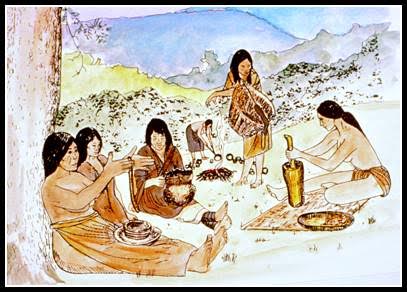
Lenape women making pottery
The Delaware Indian women had a reason for most of the things they did. Even with cooking, we think that the person’s mind when they are cooking has something to do with the health of the ones who eat the food. The cook must be in a good frame of mind during the food preparation, not angry, or ill, and have an inside prayer to the Creator that what she prepares will bring strength and happiness to the consumer of the food. Sewing likewise is not done when one is angry lest the wearer will feel unhappy when wearing it. They will feel the “makers” sensations.
Delaware women, especially when we cook outside such as when we camp out, we bend from our waist down to stir our pots. Usually a white woman will stoop down on her knees to attend her cooking pot. That is one of the differences that I see. Then too we old traditional people have a habit of pointing with our lips. Like you say, “Well, right over there,” and we point that direction with our lips. But you don’t point at people. And neither do you point at graves.
The children in a Lenape family were cared for by both parents, although some of the time the father was gone hunting or fishing as this was necessary for survival, it was not for sport as is usually the case these days. In the traditional families the children were spaced about three to four years apart, and the women usually nursed their children until they were about three years old.
In the Delaware tribe the women disciplined children in the old way. They didn’t really use any whips or any paddles or anything. They were taken to the creek, and a basket put over their head and water thrown over that basket. The Lenape said that there is a grandfather spirit in this water will correct all your bad habits, and this water will take away all these obstinate traits you might have. There is another way to correct children. You tell the child that, “Your conduct, your action, brings shame to me and all the people who are gone, you bring shame upon them.”
The woman had the freedom to do as she pleased, and she might ask her husband if he wanted to go to some certain place, but if he did not she would just take the children and go, such as to town or to a dance, (most of our dances do not require a partner). Some women also had a special man friend, a non-relative called by the term usually reserved for a female friend, and he served the purpose of a confidant. It was to him she would go with questions or problems she could not discuss with her husband or male relatives.
This account shows just a few of the many facets of the life of a woman among the Lenape people. Most of the older ways have about disappeared among the younger generations as they grow up among the non-Indians, and learn many of their ways in the schools, all too often overlooking the ways of their ancestors.
Nora Thompson Dean
Dewey, Oklahoma
24 January 1983
[Artwork by Herbert and John Kraft]
How’s Your Lenape?
Nipën (Summer)
Yukwe ta nipënëmihëna,
Tekata, konaet ksëkhìksihëna,
Kwinkashëwìlhùmëna kshëlàntèke,
Shìta kawihëna enta thako nulëmëlanteke.
Test your knowledge of the Lenape language. For the English translation, go to the bottom of page 21 (or, even better, practice by looking it up in the Lenape Talking Dictionary at http://www.talk-lenape.org)
Poem submitted by Jim Rementer
How Well Do You Know Lenape?
Nipën (Summer): English translation
Yukwe ta nipënëmihëna,
We are now experiencing summer,
Tekata, konaet ksëkhìksihëna,
Be careful, we might get sunburned,
Kwinkashëwìlhùmëna kshëlàntèke,
We like to go swimming if it is hot weather,
Shìta kawihëna enta thako nulëmëlanteke.
Or we will sleep in the shade if it is hot and humid.
Extinct Birds the Lenape Knew
The two birds shown below were well known to the Lenape people. Now they are both extinct. Only the Lenape name for the Passenger Pigeon is remembered. As we were forced westward we moved out of the area where the Carolina Parakeets were and their name became lost to us.
We are showing these two illustrations by the painter John James Audubon to remind those who view these pages how fragile the other inhabitants of our world can be, and how we all need to take care of our “Mother Earth.”
Click on the Lenape name to hear the bird’s name as pronounced by Lenape speaker Nora Thompson Dean.
 |
Amimi
Passenger Pigeon (Ectopistes migratorius) NOW EXTINCT !! |
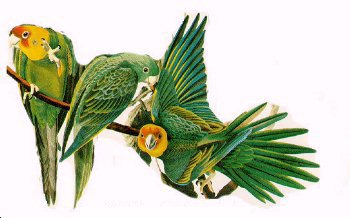 Carolina Parakeets |
The Passenger Pigeon was one of the most abundant bird species on earth not long ago. Lenape elder Ohëlëmitakwsi (James Thompson) told how, when he was a boy in Indian Territory (now Oklahoma) in the 1870s, he saw a flock fly over, and it took almost twenty minutes for them to pass.
They were driven to extinction by uncontrolled commercial hunting for the settlers. The pigeons’ migration and nesting made them easy to hunt in large numbers. By 1850, several thousand people were employed in the passenger pigeon industry. In New York, one operation alone processed 18,000 pigeons each day in 1855.
In 1914 the last Passenger Pigeon died at the Cincinnati Zoo. Before their extermination, a single flock of passenger pigeons could have two billion birds or more, and there were many flocks in the United States.
The Carolina Parakeet was America’s only native parrot. They lived over much of the United States east of the great plains. Their numbers began to decrease in the early 1800s. As the settlers began to farm more land, the Parakeets would flock to the fields and orchards, destroying the crops. The settlers could easily kill the birds as when one of their flock was shot, the others would fly around their fallen friend instead of flying away for safety. It was because of this behavior that the entire flock could easily be destroyed.
The birds were also shot for their colorful feathers which were sold to decorate women’s hats. It is also thought that the destruction of their habitat may have contributed to their decline. By the 1890s, Carolina Parakeets were very rare.
The last known pair of Carolina Parakeets had lived in the Cincinnati Zoo for thirty-five years, and they were named “Incas” and “Lady Jane.” In the summer of 1917, Lady Jane died, leaving Incas spiritless and mournful, and alone, the last of his kind, he “died of grief” on 21 February 1918.
Lenape Names for Birds
On this page are photos and the Lenape names for some common birds. Click on the Lenape name to hear the bird’s name as pronounced by Lenape speaker Nora Thompson Dean. For those images with a speaker icon at the bottom, you may also click on the bird’s photo to hear its call.
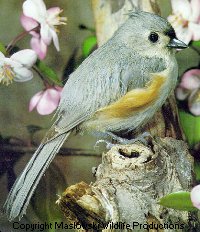 |
Tànktiyas
Tufted Titmouse (Parus bicolor) |
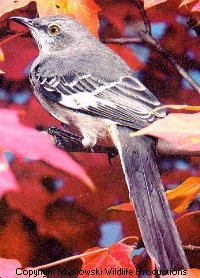 |
Tàskëmus
Mockingbird (Mimus polyglottos) |
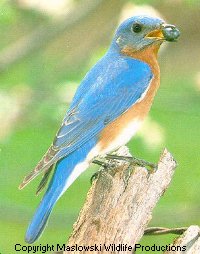 |
Chihopèkëlis
Eastern Bluebird (Sialia sialis) |
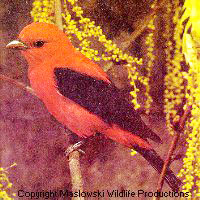 |
Wetënteis
Scarlet Tanager (Pirange olivacea) |
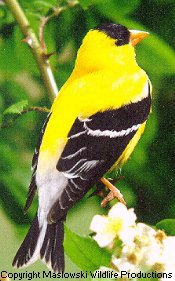 |
Wisawtayas
American Goldfinch (Carduelis tristis) |
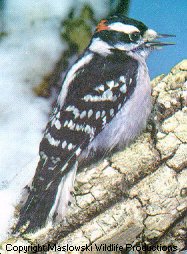 |
Tihtës
Downy Woodpecker (Picoides pubescens) |
 |
Sënihële
Sparrow Hawk or American Kestrel (Falco sparverius) |
 |
Hinutët
Wren (Picoides pubescens) |
 |
Chiskukus
Robin (Turdus migratorius) |
 |
Lelèmpëlis
Ruby-Throated Hummingbird (Archilochus colubris) |
These copyrighted photographs are used courtesy of Maslowski Wildlife Productions. We would like to thank them for giving us permission to use these fine photographs.
See also: Extinct Birds the Lenape Knew
Common Words and Phrases, Page 2
Click the Lenape word to hear it pronounced.
| Lenape | English |
|---|---|
| PHRASES | |
| Wanìshi | Thank you |
| Kulamàlsi hàch? | Are you well? |
| nulamàlsi | I am well |
| mpalsi | I am sick |
| nëwikwihëla | I am tired |
| ntakòhchi | I am cold |
| mënihi | Give me a drink |
| mushhakòt | the sky is clear |
| kùmhòkòt | the sky is cloudy |
| pèthakhòn | it is thundering |
| kshàxën | it is windy |
| wine | it is snowing |
| BIRDS AND ANIMALS | |
| ahas | crow |
| òkwës | fox |
| chinkwe | bobcat |
| pukwès | mouse |
| sànkwe | weasel |
| tëme | wolf |
| xanikw | squirrel |
| chulëns | bird |
| ntalëmuns | my pet |
| MORE NUMBERS | |
| kwëtash | six |
| nishash | seven |
| xash | eight |
| pèshkunk | nine |
| tèlën | ten |
| kwëtash, nishash, xash, pèshkunk, tèlën | six thru ten |
| Sounds: a – father, à – up, e – gate, è – get, ë – above, i – me, ì – pick, o – open, ò – for, u – boot, ù – look, x – nacht (as in German). | |
Common Words and Phrases
Click the Lenape word to hear it pronounced.
| Lenape | English |
|---|---|
Hè
|
Hello! (or) Hi! |
Làpìch knewël
|
I will see you again. (Goodbye) |
tëmike
|
Come in! (or) Go in! |
lëmatahpi
|
Sit down! |
wëntaxa
|
Come here! |
mitsi
|
Eat! (speaking to one person) |
mitsikw
|
You eat! (speaking to two or more) |
mitsitàm
|
Let’s eat! |
tukihëla
|
Wake up! |
taktani
|
I don’t know |
nkatupwi
|
I am hungry |
nkatusëmwi
|
I am thirsty |
nkatungòm
|
I am sleepy |
mili kàpi
|
Give me some coffee |
Lënape nàn
|
He (or she) is a Lenape |
Lënape hàch nàn
|
Is he a Lenape? |
ktalënixsi hàch
|
Do you speak Lenape? |
kèxiti
|
a little |
kèku hàch lakeyu
|
What tribe (or nationality) is he? |
wëli kishku
|
It is a good day |
lëlëwàxën
|
There is a breeze |
shëlànde
|
It is a hot day |
sukëlan
|
It is raining |
kwëti
|
one |
nisha
|
two |
naxa
|
three |
newa
|
four |
palenàxk
|
five |
kwëti,nisha, naxa, newa, palenàxk
|
one, two, three, four, five |
| PHRASES | |
Wanìshi
|
Thank you |
Kulamàlsi hàch?
|
Are you well? |
nulamàlsi
|
I am well |
mpalsi
|
I am sick |
nëwikwihëla
|
I am tired |
ntakòhchi
|
I am cold |
mënihi
|
Give me a drink |
mushhakòt
|
the sky is clear |
kùmhòkòt
|
the sky is cloudy |
pèthakhòn
|
it is thundering |
kshàxën
|
it is windy |
wine
|
it is snowing |
| BIRDS AND ANIMALS | |
ahas
|
crow |
òkwës
|
fox |
chinkwe
|
bobcat |
pukwès
|
mouse |
sànkwe
|
weasel |
tëme
|
wolf |
xanikw
|
squirrel |
chulëns
|
bird |
ntalëmuns
|
my pet |
| MORE NUMBERS | |
kwëtash
|
six |
nishash
|
seven |
xash
|
eight |
pèshkunk
|
nine |
tèlën
|
ten |
kwëtash, nishash, xash, pèshkunk, tèlën
|
six thru ten |
| Sounds: a – father, à – up, e – gate, è – get, ë – above, i – me, ì – pick, o – open, ò – for, u – boot, ù – look, x – nacht (as in German). | |
The Last Removal
A painting by Lenape artist Jacob Parks
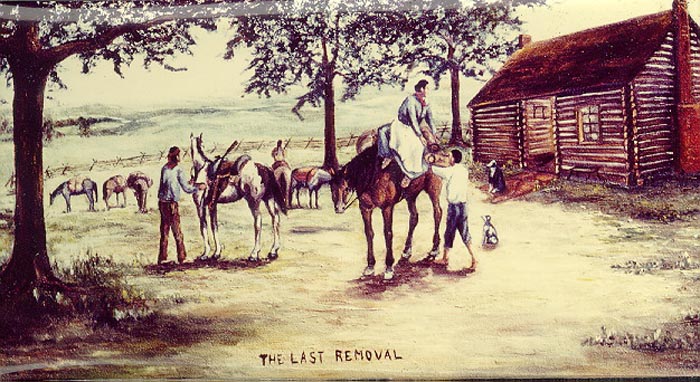
- THE LAST REMOVAL — A painting by Lenape artist Jacob Parks (1890-1949), which depicts a Lenape family leaving their home on their reservation in Kansas in 1867. This area had been their home for over thirty-five years, and now the government told them they had to move to Indian Territory (now Oklahoma).
The Walking Purchase
In Lenape history there is the story of the “Walking Purchase” which took place in 1737. William Penn had always dealt fairly with the Lenape, but after he returned to England his sons and other agents began to sell land to pay their creditors, and these were lands which were still owned by the Lenape.
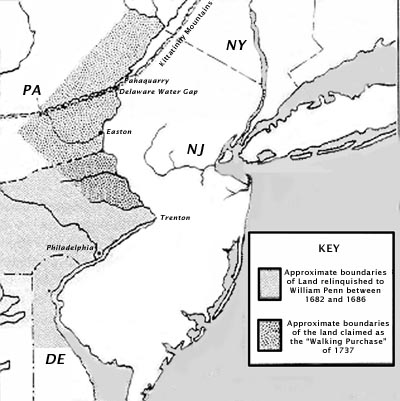 In order to convince the Lenape to part with the land, the Penns falsely represented an old, incomplete, unsigned draft of a deed as a legal contract. They told the Lenape that their ancestors some fifty years before had signed this document which stated that the land to be deeded to the Penns was as much as could be covered in a day-and-a-half’s walk.
In order to convince the Lenape to part with the land, the Penns falsely represented an old, incomplete, unsigned draft of a deed as a legal contract. They told the Lenape that their ancestors some fifty years before had signed this document which stated that the land to be deeded to the Penns was as much as could be covered in a day-and-a-half’s walk.
Believing that their forefathers had made such an agreement the Lenape leaders agreed to let the Penns have this area walked off. They thought the whites would take a leisurely walk down an Indian path along the Delaware River. Instead, the Penns hired three of the fastest runners, and had a straight path cleared. Only one of the “walkers” was able to complete the “walk,” but he went fifty-five miles.
And so by means of a false deed, and use of runners, the Penns acquired 1200 square miles of Lenape land in Pennsylvania, an area about the size of Rhode Island! The Lenape people complained about the way the “walk” had been done. Lenape chief Lappawinsoe expressed the frustration and dissatisfaction of the Lenape when he said:
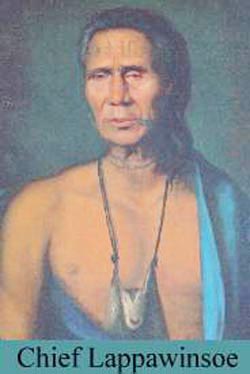 [the white runners] should have walkt along by the River Delaware or the next Indian path to it… should have walkt for a few Miles and then have sat down and smoakt a Pipe, and now and then have shot a Squirrel, and not have kept up the Run, Run all day.
[the white runners] should have walkt along by the River Delaware or the next Indian path to it… should have walkt for a few Miles and then have sat down and smoakt a Pipe, and now and then have shot a Squirrel, and not have kept up the Run, Run all day.
Nonetheless, the Lenape felt honor-bound to fulfill what they thought their ancestors had agreed to, and thus began their movement westward. The Lenape were given place after place. Each time it was promised by the government that it would be their permanent home, only to have to move again. Their trek, which lasted 130 years, finally brought them to what was known as Indian Territory, now Oklahoma.
Lenape Men’s Clothing — The Bandolier
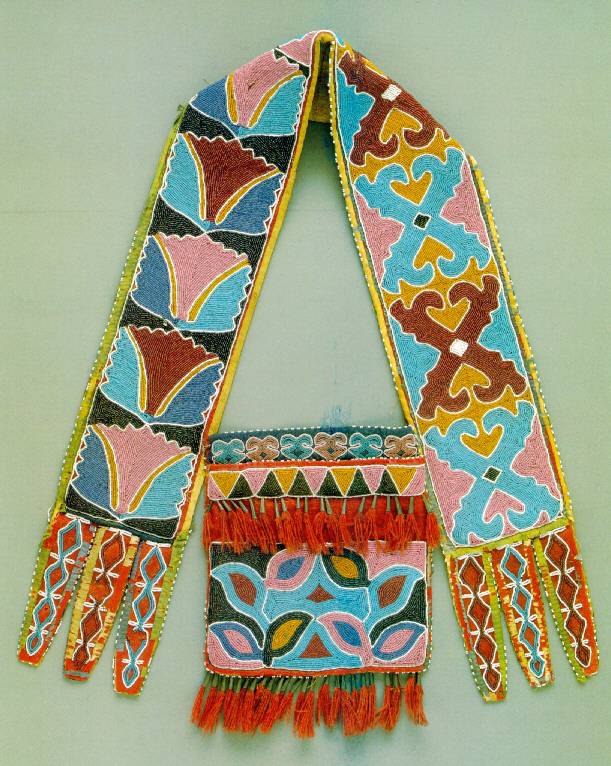
- One item worn by Delaware men was the Bandolier Bag. This had a wide, fully beaded shoulder strap 2 to a beaded bag. A number of these are now in museums as they were a favorite of collectors.

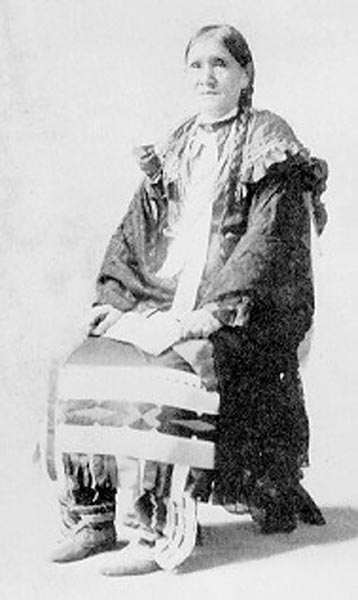
 D5 Creation
D5 Creation